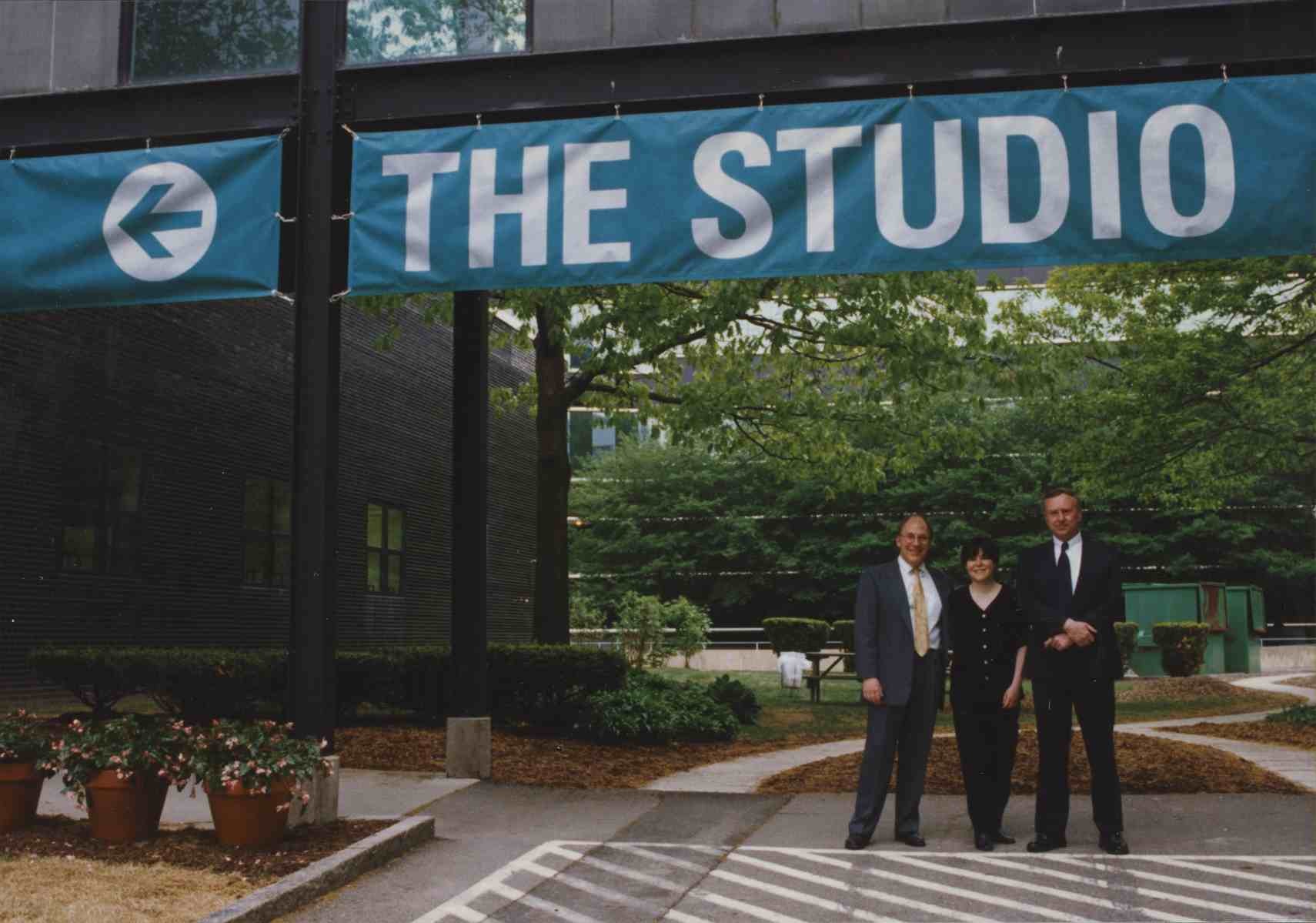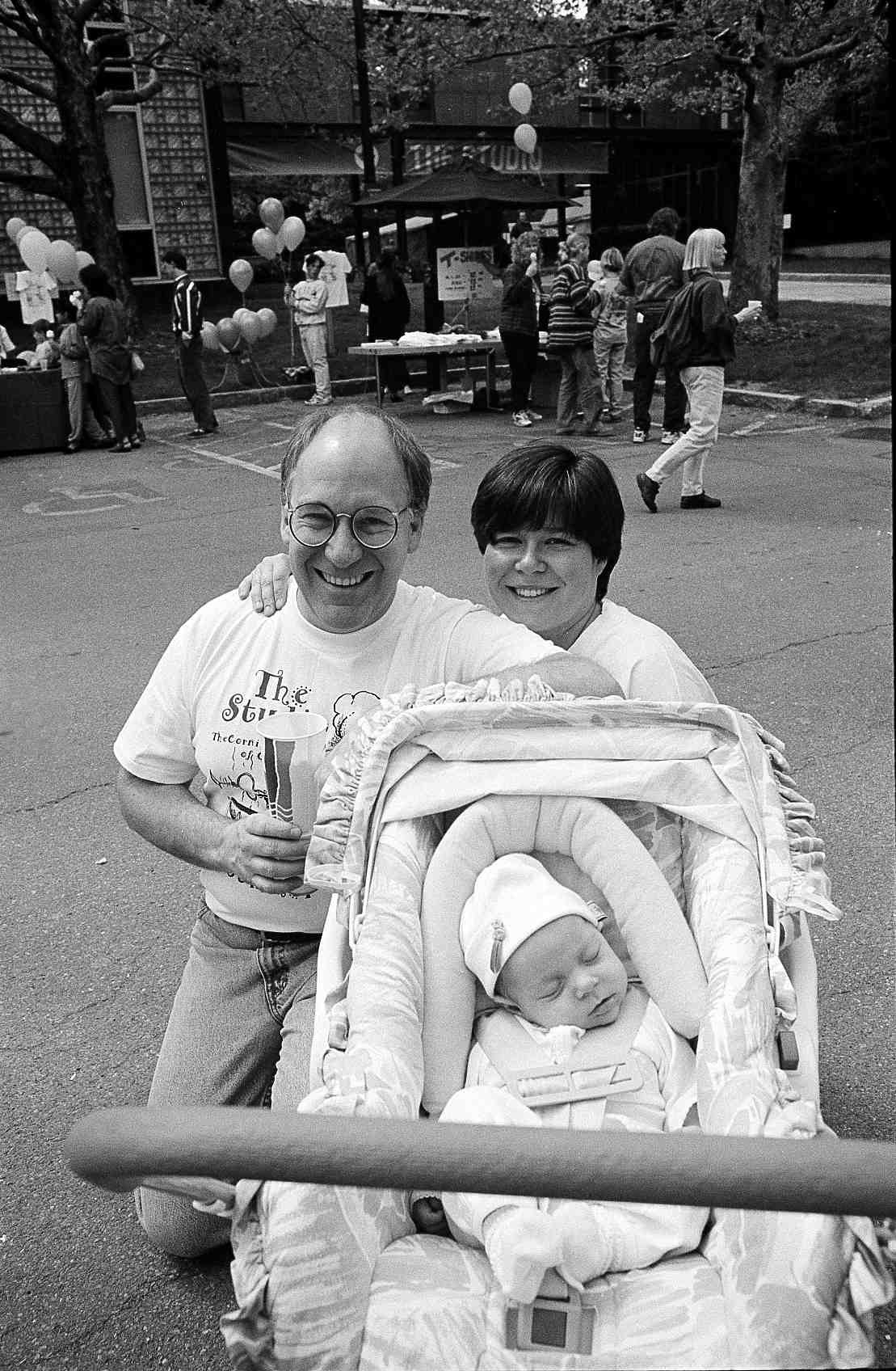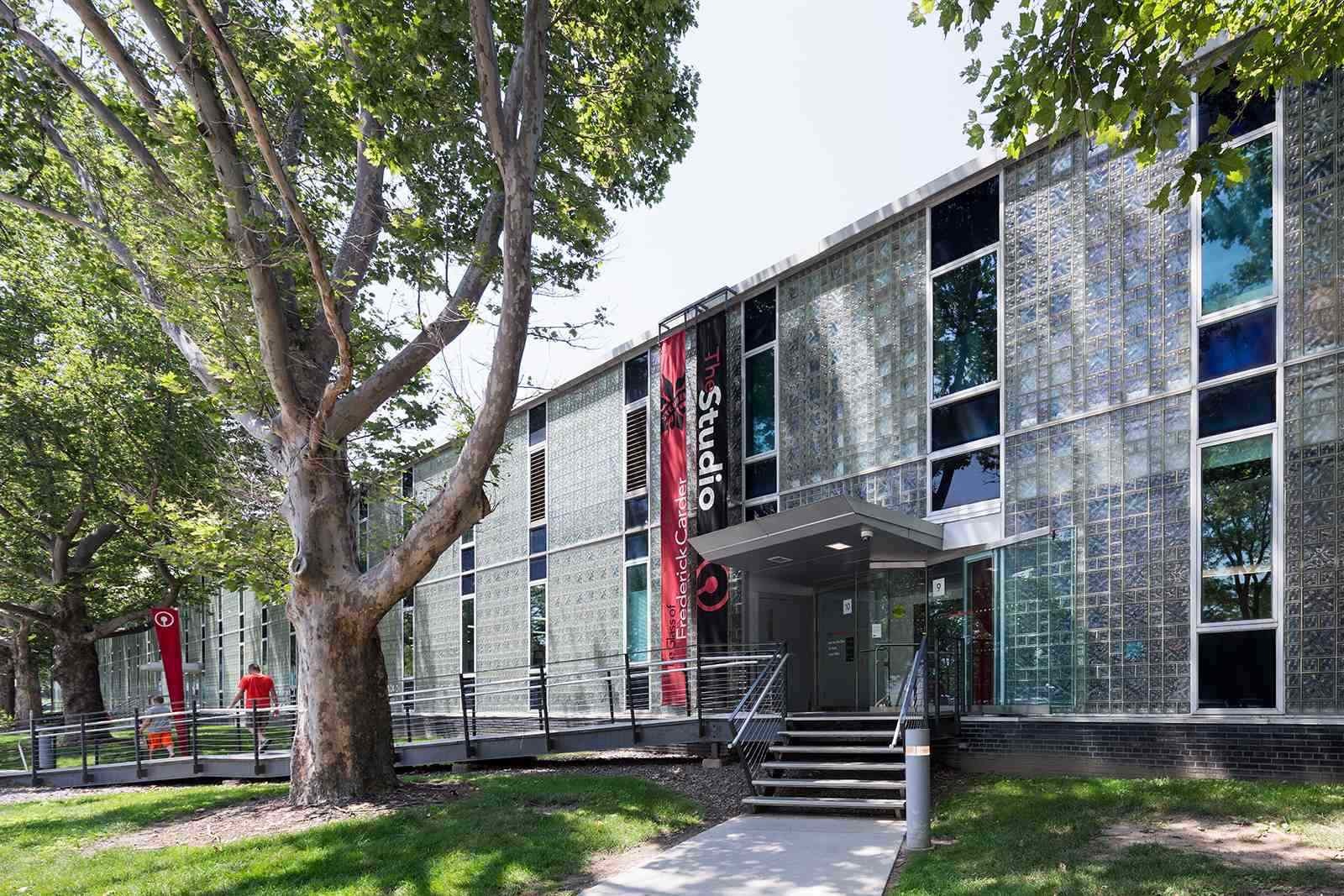In 1995, a pregnant Amy Schwartz and her husband, William Gudenrath, relocated to Corning, New York, at the invitation of museum director David Whitehouse (1941-2013) to begin the planning for The Studio at The Corning Museum of Glass, a new initiative that would redefine and expand the museum's role as a place where glass was not only studied and exhibited but also made and taught. To take their new positions as studio director and resident advisor, respectively, Schwartz and Gudenrath were both leaving jobs in New York City — she managed the computer system of a law firm on Wall Street and he was a longtime instructor at UrbanGlass (and one of the first to join its precursor, The New York Experimental Glass Workshop). The Studio at Corning opened its doors in 1996 with a block party that included an ice cream truck and guests such as gallerist Doug Heller and artist Paul Stankard. The couple's newborn daughter, Sophia, also attended the Studio's opening on May 26, 1996, taking it all in from a stroller. Twenty years later, as the studio has hosted hundreds of instructors and artists in residence, as well hundreds of thousands of museum visitors making their own glass, the GLASS Quarterly Hot Sheet spoke with the Studio's director about the highlights of the past two decades.
GLASS Quarterly Hot Sheet: Can you tell us some of the things that are planned for the big twentieth anniversary event coming up on May 26th?
Amy Schwartz: The Studio’s twenty, we’re turning twenty! Isn't it just so hard to believe? In the morning of the 26th, we’re doing a community celebration and opening up the studio so artists can do some work, community people can come, renters, artists. There will be coffee and muffins for everybody. Then, from 11 to 1 in the afternoon, we're having a block party outside, which is what we did on the day we opened twenty years ago. We're going to have six food trucks, an ice cream truck, and we’ll have party balloons, t-shirts and some other stuff. And so I’m hoping to recreate what we did twenty years ago, with that wonderful feeling we had.
After everybody’s eaten, we're having John Miller do a demo in the studio, he's going to make a giant cupcake out of glass, and there will be cupcakes for everybody. Then, we're going to parade a big gather of glass through the studio, take it outside and down the ramp. Then, with motorcycle escorts, we'll parade it across the parking lot to the Amphitheater Hot Shop, where Bill and I will pull the gather and someone will cut it and it will be a sort of ribbon-cutting that kicks off Glassfest, a three day community event that is happening at Corning. Then this will start 2300 degrees at the amphitheater, where the featured artist will be Bill Gudenrath celebrating the studio, with the same band that played at the opening of the contemporary wing, Break of Reality.
Inside the museum will be the opening of an exhibition at the West Bridge called "The Studio at 20," which features work by artists who have taught intensives or been artists in residence at the Studio who also have work in the museum's permanent collection. There are a total of 24 cases, and we're also going to list all the names of all the insturctors who have taught at the Studio. We're kind of excited about this because the work will be on view during the upcoming Glass Art Society conference. For those who can't get here, they can go online to see the work in the collection sets.
GLASS: Thinking back to 1996, when the Studio was just getting off the ground, what was it like, especially after moving out of fast-paced life in New York City?
Amy: I was just totally excited to do something bigger than myself. I just found glass so magical, and a chance to bring all the people together around glass, it was very exciting. I had no idea at the time how big it would get, it’s been satisfying and successful the whole time.
GLASS: What was your life like before the Studio?
Amy: I was working on Wall Street and blowing glass at UrbanGlass at night. Bill and I had met in a class (he was my instructor), and he had a relationship with the director of the museum. David [Whitehouse] knew that Bill’s name and reputation would attract people, and that I could help make it all happen. When we moved here I was three-months pregnant. I remember starting work on the program. We invited all our friends to teach, then we started working on the layout of the space and the construction. Our daughter was born at the end of March, and six weeks later we opened up for business. Bill and I like to say that Sophia was our first baby and the studio our second.
GLASS: Were you worried, being so far away from a major metropolitan area that people woudn't want to make the trip to Corning? Was it possible that the Studio would not be a success?
Amy: Maybe we didn’t think about it, but everyone we told about our adventure, all our friends, they said they would come. Lino [Tagliapietra] said he would come, Paul [Stankard] said he would come, everyone in our wide network of friends. We had such long waiting lists for our classes the first few years, you could say it was an immediate success. Every class was full with 30 people on the waiting lists. We never felt tentative. We had a mission to be a leader in the international glass community and a creative resource for the region.
GLASS: What about within The Corning Museum of Glass itself? Were there naysayers who thought a studio was not part of the mission of a museum, much less the leading institution devoted to scholarship and exhibitions about glass?
Amy: I think it was the opposite. I think the museum was a different place then, smaller and not as vibrant as it is now. I think the Studio brought a lot of life to the institution, which spilled over to the museum. In fact, in the charter of the museum there was the idea to have the studio, and David was very good at getting the corporate people interested in what we were doing. Also, there was a studio where people blew glass in the town of Corning. It had been supported by a local arts organization but just lost its funding because it was too expensive compared to other programs they were doing like dance. Rodi Rovner, who was running that program, called me up and said, you guys should come up here. She so cared about glass in Corning. I was always worried the Studio at Corning might somehow have a negative affect on her but her studio, Hands-On Glass, has grown as well.
GLASS: How did you see the Studio in relation to the other well known educational programs such as Pilchuck?
Amy: I feel like we are more collaborators than competitors. Also, each center of education has a different character. Pilchuck has always been Dale Chihuly and Seattle and woods, Penland is mountains, Haystack is ocean. I felt those were our main competitors. At the time, UrbanGlass was mainly doing short courses, so I didn’t think of them as a competitor, and it has also always been a part of the New York art scene in a unique way. Corning had the museum and library and the glassy town of Corning. I felt we each had our own personalities, and that there was room for everyone. The Studio's strong points were all the glass, all the experts, the support, the scientists, the curators.
GLASS: How does the Studio at Corning stay connected with the local community?
Amy: Every year, we do a holiday open house, where we offer a discounted activity, people can make some glass. It's amazing how many local people bring their families or visitors from out of town. Around the holidays, people wait for hours, and it's the same families. We see kids grow up, make their ornaments each year. The Corning community is very proud of the museum as a whole. I think we train a lot of the young glass artists, they can work there in the summer, it’s a fantastic place. I guess you can say I've drunk the Kool-Aid.
GLASS: How important is the artist residency program as part of the Studio's activities, and how has it changed over the years?
Amy: For me that was a labor of love. And we've raised all the money to fund that program since day one from individual donations and grants, and through our annual holiday sale and open house, which also funds our scholarships. We started with a couple residents a year, now we have a dozen each year. I always wanted the studio to be advocates for artists. We don’t ask much from them — a short lecture, and we don’t insist on it. Some donate a piece to our case, but it's optional. The artists – I think of it as a 5-star hotel. With the new Amphitheater Hot Shop that was built as part of the new contemporary wing, we can offer visiting artists the opportunity to have things fabricated by the team there, which makes us a little more open to the design community. So I've opened up a little more about the artists being totally self-driven, self-fabricating. We're much more open now, but if I can invite artists in who do their own work, then I don't have to find four gaffers to blow for them.
GLASS: What has been the biggest surprise for you these past two decades — the thing you didn't expect when you started the Studio?
Amy: I didn’t expect glass to grow so much. It’s everywhere now. I just saw a commercial for Aleve where you see a guy golfing, someone in an office doing some work, and then someone blowing glass. It seems to be everywhere, how accessible it has become.
GLASS: While there might be growing awareness of glassmaking, as you know there has been a lot of soul-searching as the collector base for glass art is aging and buying less from galleries and from artists. What are your thoughts?
Amy: I think the collectors are aging out and their kids aren’t as interested. So a lot of these collectors are trying to get their grandchildren interested. I have to tell you that I see a new group of people being interested, not always in collecting glass, but they are willing to support it in other ways. Glass is expensive, and it appeals to a range of professional people who have had careers in other places, want to give back, be supportive, and do it themsevles. The most-interesting thing for me is how glass makes connections between people, even those with different backgrounds. I love that there’s an older man who has had a successful career in something else, is fascinated by working in cane. And then he who hooks up with a 20-year-old art student who also likes cane, and they've become good friends.
GLASS: How have new technologies, such as digital prototyping, impacted the Studio and its activities?
Amy: I suppose it could affect us in some ways, and that could change the community. But I think glass people are resourceful. We’re starting to incorporate 3D printing into the resources of the Studio, we're going to have a class this summer and will offer one next summer. And it will be avaiable to our visiting artists, so basically, we’ll continue to work with artists as they are developing new approaches to things, and we want to be able to offer whatever technology they ask for. We hope to expand at some point, and in our expansion plan we want to have a fab lab, offer the latest technology for artists, and have our staff know how to use it. Glenn Cook is coming over to the Studio as chief scientist at the museum. We've always worked with the Corning scientists, but now we have someone on staff. I guess we’re learning as the artists are learning.
IF YOU GO:
"The Studio 20th Birthday: Celebratory Day" May 26, 2016 from 9 AM to 8 PM The Studio at The Corning Museum of Glass One Museum Way Corning, New York Tel: 800.732.6845 Online Schedule of Events






